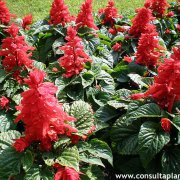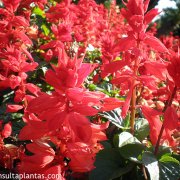Care of the plant Salvia splendens or Scarlet sage |
|
The genus Salvia, family Lamiaceae, comprises 1,000 species of shrubs and herbaceous plants native to Asia, Africa, the Mediterranean region, and Central and South America. Some species are: Salvia splendens, Salvia scabra, Salvia nemorosa, Salvia namaensis, Salvia microphylla, Salvia mexicana, Salvia mellifera, Salvia leucantha, Salvia lanceolata, Salvia guaranitica, Salvia greggii, Salvia farinacea, Salvia disermas, Salvia canariensis, Salvia aurea, Salvia apiana, Salvia africana, Salvia vaseyi, Salvia leucophylla, Salvia verbenacea, Salvia sclarea, Salvia officinalis, Salvia fruticosa, Salvia elegans, Salvia x sylvestris. Common name: Scarlet sage, Tropical sage. This species is native to South America. They are perennial herbaceous plants that are usually grown as annuals and that reach 60 cm (1.96 feet) in height. The leaves are glossy dark green and contrast with the showy red flowers; There are white, pink and purple varieties. They can bloom from late spring to early fall. Scarlet sage is used in flower beds, to create patches of color on lawns, in raised planters, and in pots for terraces, balconies and patios. Salvia splendens needs full sun exposure and a warm climate. It does not resist frost. Tropical sage prefers acidic soils that contain organic matter and coarse sand for good drainage. Water regularly in spring, summer and autumn so that the substrate does not dry out completely but never flood; water sparingly in winter. Excess moisture is very harmful to these plants. Fertilize every 15 days during flowering with a mineral fertilizer. Prune withered flower spikes to encourage the appearance of new spikes. Salvia splendens can be attacked by snails and slugs. Scarlet sage is propagated from seedlings in the nursery in early spring. The plants obtained are planted in their final location in mid-spring at a distance of 30 cm (11.8") between them. If the weather is warm (frost free) it can propagate by division. |
Images of the plant Salvia splendens or Scarlet sage |
Find plants
Salvia splendens or Scarlet sage | Care and Growing
© 2026 FavThemes


